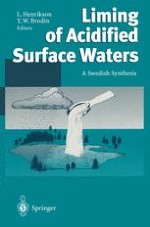1995 | OriginalPaper | Buchkapitel
The effects of liming on aquatic flora
verfasst von : Stefan Larsson
Erschienen in: Liming of Acidified Surface Waters
Verlag: Springer Berlin Heidelberg
Enthalten in: Professional Book Archive
Aktivieren Sie unsere intelligente Suche, um passende Fachinhalte oder Patente zu finden.
Wählen Sie Textabschnitte aus um mit Künstlicher Intelligenz passenden Patente zu finden. powered by
Markieren Sie Textabschnitte, um KI-gestützt weitere passende Inhalte zu finden. powered by
Most studies of the effects of liming on the flora of lakes and watercourses have concentrated on phytoplankton, while little attention has been devoted to epiphytic algae, macrophytes and wetland flora.Lake liming results in an initial decline in the phytoplankton biomass, although this is generally followed by an increase after 1–2 months. The post-liming biomass may be either greater or lesser than it was during the acidification phase and a long-term decline has been observed in certain cases. New species become established and, in most lakes, the number of species increases. The composition of species changes, from initially being dominated by dinoflagellates (Dinophyceae) or blue-green algae (Cyano phyceae) to a community containing greater variety, with golden-brown algae (Chrysophyceae), green algae (Chlorophyceae) and diatoms (Bacillariophyceae). It has often been possible to observe a shift from larger to smaller plankton species. There is a suggestion that suspended calcium particles cause a release of microscopic algae from the bottom sediment, which may partially explain the unexpected algal blooms that have been observed after liming. The risk of algal blooms is probably greater, however, in cases where the acidification damage is more extensive. Few studies have been carried out on primary production among phytoplankton and no clear effects have been identified. If lakes are limed early on in the acidification phase, i.e. before extensive biological damage has occurred, less far-reaching changes are involved than if the lake has had time to become severely acidified.Mougeotia, a filamentous green alga, which thrives under acidic conditions, disappears after liming but may become re-established if the water becomes re-acidified. Felt carpets of filamentous blue-green and green algae decline. Epiphytic growths of certain species of desmids (e.g. Desmidiales) on water lobelia (Lobelia dortmanna) increase.Macrophyte species usually increase after liming, but it may take time — up to several decades — for new colonies to become established. Sphagnum mosses decline sharply, with a consequent reduction in biomass in the most acidified lakes, and colonization of surfaces previously covered by Sphagnum is usually slow. Proliferation of alternate water milfoil (Myriophyllum alterniflorum) has been observed in a number of shallow lakes after repeated liming treatments.Severe damage to wetland vegetation has been observed after liming Sphagnum mosses are completely eliminated in many cases, and other species such as Polytrichum mosses usually become established in places where the Sphagnum has died out. Liverworts (Hepaticae) and lichens often suffer as well. The field layer is affected in the long term through an increase in the dwarf-shrub layer, among other things. The long-term biological and hydrological effects of ground-layer damage in wetlands have not been studied.
